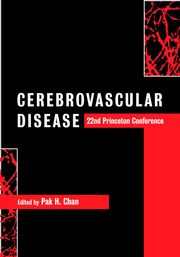Book contents
- Frontmatter
- Contents
- List of contributors
- Preface
- Acknowledgments
- Part I Special lectures
- Part II Oxidative stress
- Part III Apoptosis
- Part IV Hot topics
- Part V Hemorrhage, edema and secondary injury
- Part VI Inflammation
- 18 Inflammation and stroke: benefits or harm?
- 19 TNF-α and ceramide are involved in the mediation of neuronal tolerance to brain ischemia
- 20 Sites and mechanisms of IL-1 action in ischemic and excitotoxic brain damage
- 21 Protease generation, inflammation and cerebral microvascular activation
- Part VII Gene transfer and therapy
- Part VIII Neurogenesis and plasticity
- Part IX Magnetic resonance imaging in clinical stroke
- Part X Risk factors, clinical trials and new therapeutic horizons
- Index
- Plate section
19 - TNF-α and ceramide are involved in the mediation of neuronal tolerance to brain ischemia
from Part VI - Inflammation
Published online by Cambridge University Press: 02 November 2009
- Frontmatter
- Contents
- List of contributors
- Preface
- Acknowledgments
- Part I Special lectures
- Part II Oxidative stress
- Part III Apoptosis
- Part IV Hot topics
- Part V Hemorrhage, edema and secondary injury
- Part VI Inflammation
- 18 Inflammation and stroke: benefits or harm?
- 19 TNF-α and ceramide are involved in the mediation of neuronal tolerance to brain ischemia
- 20 Sites and mechanisms of IL-1 action in ischemic and excitotoxic brain damage
- 21 Protease generation, inflammation and cerebral microvascular activation
- Part VII Gene transfer and therapy
- Part VIII Neurogenesis and plasticity
- Part IX Magnetic resonance imaging in clinical stroke
- Part X Risk factors, clinical trials and new therapeutic horizons
- Index
- Plate section
Summary
Introduction
We have been interested in models of tolerance to hypoxia and ischemia as potential guides to appropriate therapeutic targets because of the complexity and multifactorality of the process that causes progressive brain damage during the early hours of a stroke. After having been exposed to single or repetitive episodes of sublethal ischemic stress, brain cells acquire resistance to subsequent, otherwise lethal, ischemic insults. A number of biochemical changes, such as cytokine release, that trigger activation of multiple signaling pathways are caused by ischemic stress and other forms of stress.
Tumor necrosis factor-alpha (TNF-α), a cytokine with pleiotropic activity, affects many different types of cell. Whole brain, neurons, microglia, astrocytes and brain endothelium are not only capable of TNF-α synthesis in response to stress, but also express TNF-α receptors and amplify the TNF-α response through paracrine and autocrine mechanisms. In addition, this cytokine has been implicated in both detrimental and neuroprotective actions in brain cells, depending on the experimental conditions. This dual function of TNF-α has also been observed in vivo. The TNF-α-binding protein that neutralizes TNF-α had a protective effect against focal ischemia. However, in a model of permanent middle cerebral artery occlusion, transgenic mice lacking TNF-α receptors developed significantly larger infarcts than did littermate controls. An inference from these data is that TNF-α has the potential to function either as a stressor or as a molecule with a homeostatic function.
- Type
- Chapter
- Information
- Cerebrovascular Disease22nd Princeton Conference, pp. 226 - 236Publisher: Cambridge University PressPrint publication year: 2002



